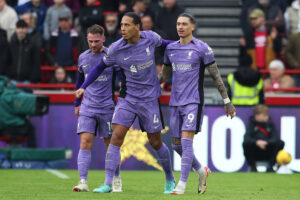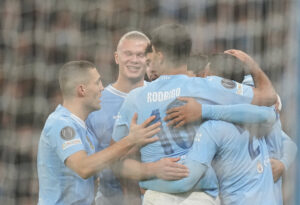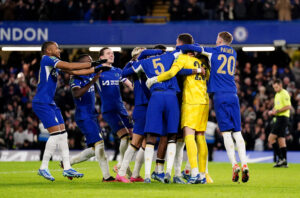The 2018 World Cup will feature a plethora of superstars, both young and experienced. The world will be watching, however, making the occasion a stage to shine for the young. Many young stars, however, have already established themselves on the world’s stage. These include Marco Asensio, José Giménez, Joshua Kimmich, Kylian Mbappé, Marcus Rashford, Leroy Sané and more. Others, however, such as Sergej Milinković-Savić, have just begun to impress and will use this tournament as a springboard for their promising careers.
Sergej Milinković-Savić Among Youngsters to Watch at World Cup
Leander Dendoncker
Belgium boss Roberto Martinez made the bold decision to not include Radja Nainggolan in his World Cup squad. This was not purely a tactical decision, but it showed that Martinez has plenty of faith in his other midfielders.
Although not an explosive player like Nainggolan, Dendoncker has proved to be reliable at the club level for Anderlecht. He is defensive-minded, which Martinez definitely kept in mind knowing Kevin De Bruyne would be the creator in the midfield. He excels at breaking up opponent’s build-up play in the midfield with his knack for intercepting the ball and has slowly grown into a role of a deep-lying passer. Furthermore, Dendoncker’s frame allows him to overpower opponents and be dominant in the air.
Dendoncker keeps most of his play very tidy without much risk-taking. This is perhaps a reason why he has not quite made himself known on the world stage just yet. With talented forwards such as Eden Hazard and Romelu Lukaku, this has potential to change. If he can find consistent play time, Dendoncker can elevate his value and perhaps finally move on from the Belgian First Division.
Aleksander Golovin
Although only 21, Russians are quite familiar with Golovin. In 2013, he shined in the U-17 European Championship, leading Russia to the title. Two years later, he once again shined in the U-19 version, leading Russia to the final. His performances earned him his first senior appearances in 2015, where he scored in his first two matches. In his first season as a regular for CSKA Moscow, he played a role in leading them to the league title in 2016.
Golovin primarily features as a centre midfielder, but his versatility has seen him play on the wing and even as a striker on one occasion. This, however, shows that he primarily focuses on attacking rather than defending. This past club season he managed to score seven goals and assist four others. He has yet to break out as a star, but his growth has been rapid.
Russia will be playing with a chip on their shoulder as the hosts of the World Cup. Golovin already has experience in playing in meaningful tournaments, as he has featured in the senior European Championship, the Champions League and the Europa League. If Russia truly hopes to make a mark on their World Cup campaign at home, Golovin’s youthful energy will be relied upon.
Giovani Lo Celso
Lo Celso has already managed to earn significant playing time for French powerhouse Paris Saint-Germain. This season was his best to date, where he scored five goals and assisted four. One of his better attributes, like many young players, is his versatility. Listed as a centre midfielder, Lo Celso can also play in a more attacking role or in a deep-lying playmaker position.
He has been compared to Ángel Di María in the past. Although this surely has to do with their Argentinian roots and left-foot tendencies, it isn’t far from the truth. Lo Celso is swift on the ball, he knows what he wants to do early and is accurate in his passing. He averaged a 90% passing rate in Ligue 1 and an even more impressive rate of 93% in the Champions League. The main criticism on Lo Celso, however, is that he favours his left foot far too much. Opposing scouting reports will note this, and Lo Celso must be ready for defenders to try to expose that.
Argentina made a magical run to the World Cup final last time around. Their squad this time around, however, is not as deep. If Lo Celso plays his cards right, he has the potential to find consistent pitch time or even start. Lionel Messi is heavily relied upon, and rightfully so, but the Germanys and Spains of the world will be able to slow him down. He will need help, and Lo Celso’s creativity might be what he needs.
Hirving Lozano
After shining for Pachuca in Mexico, Lozano moved to PSV Eindhoven in the Dutch Eredivisie last summer. His debut season in Europe could not have gone better – he finished with 19 goals and eight assists in all competitions, earning PSV the league title. Lozano isn’t much of a passer, however. This can be seen in his pass completion of 75%. He loves to take defenders head on and will cross the ball in if necessary. His pace and skill on the ball allows him to be successful at what he does.
He doesn’t show much defensive commitment, but is always a part of his team’s play going forward. He has already established himself as a regular for Mexico, with 26 appearances and seven goals. Mexico has plenty of talent in attack, which bodes well for Lozano as it will leave him with the one-on-one chances he thrives in versus defenders.
For Mexico to succeed, Lozano will have to play a major role in the attack and track back defensively. This will be even more important after Néstor Araujo’s injury and withdrawal from the squad. After his successful spell in the Netherlands, Lozano will have to use this World Cup to show he is ready for a new challenge.
Sergej Milinković-Savić
Sergej Milinković-Savić is well on his way to becoming one of football’s most elite midfielders. He shined for Lazio in the Italian top flight this season, and has generated interest from Manchester United. From a club standpoint, Sergej Milinković-Savić is ahead of other players in this list. He has rarely been given a chance on the international stage, however.
The eye-test would tell you that Sergej Milinković-Savić’s top assets are his frame and strength. Although he possess those two qualities, his skills, dribbling, and vision are arguably second to none in Italy. He has drawn comparisons to Paul Pogba, and these are not as far-off as some may assume. Milinković-Savić excels both defensively and offensively, even though he tends to position himself slightly more forward than others in his midfield. To become world-class, however, Sergej Milinković-Savić must improve his passing percentage. He averaged just under 79% this past season, which is solid but not spectacular. He still managed to record six assists going along with his 14 goals.
Sergej Milinković-Savić will not be fortunate enough to have the same speed on the wings with Serbia as he’s had with Lazio to create attacks. He does have the ability to take over a midfield, however, and Serbia might have to rely on that to reach their goals this summer.
Wilfred Ndidi
Ndidi had an injury scare at the end of his club season with Leicester City, but luckily he will recover in time for the World Cup. This would have been a huge blow for Nigeria as Ndidi has established himself as a defensive force in the midfield. The Nigerian averaged 4.2 tackles and 1.5 interceptions per game in a break out campaign this year.
Ndidi has drawn comparisons to former Leicester star N’golo Kanté. Although they both excel defensively, they are not too similar. Kanté is far more quick and has to rely on anticipation to succeed due to his stature. Ndidi, on the other hand, is more physical and succeeds often in the air.
As a midfielder, Ndidi must build more confidence in his passing. He’s solid in build-up play, but struggles to make effective long passes. With Nigeria’s pace going forward, Ndidi will find himself in situations where he must deliver these kinds of passes.
All in all, Ndidi will be vital for Nigeria. Their defense is far from spectacular, so he will be relied upon to break up opposing attacks before they reach the defense.
Lucas Torreira
Torreira inexplicably found himself at the bottom of the pecking order in Uruguay’s midfield during World Cup qualifying. After an impressive campaign for Sampdoria in Italy, however, he forced his way onto the team.
Although he’s short in stature, Torreria’s intense physical play has earned him the nickname of “the pit bull.” He is an ideal box-to-box midfielder. He can build-up play as seen by him completing 87% of his passes, but can break up plays with ease as well. He averaged 2.8 tackles and two interceptions per game this past season. Furthermore, he has a tendency to release a rocket of a shot.
Uruguay would be wise to use Torreria in a midfield alongside Matías Vecino and one of Diego Laxalt or Rodrigo Bentancur. His traits fit well with a defensive presence like Vecino and creators like Laxalt and Bentancur. Torreira always plays with the utmost amount of passion, the importance of which cannot be overstated in a World Cup. Star-studded European sides like Arsenal and Napoli have kept an eye on Torreira, and will likely pull the trigger on a transfer deal should he shine this summer.
The Last Word
The World Cup will be stacked with young talent. Not only can these players represent their country well, but they can also build a new reputation for themselves. For example, the last World Cup allowed Memphis Depay and James Rodríguez to break out onto the scene. Look for these players to shine and to establish themselves as stars of the game.
Main Image Credit:
Embed from Getty Images






